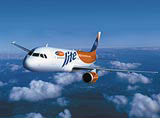Low-budget flight plans
Richard Clayton discovers whether the low-cost airlines are capable of competing on more than just price as the competition becomes more intense

Ryanair may not be the world’s favourite airline – critics note the Irish carrier’s baggage handling leaves much to be desired – but its commitment to the no-frills approach has made it one of the most successful.
The company reported a 71 per cent rise in after-tax profits for the six months to the end of September and no-nonsense chief executive Michael O’Leary predicts a five-fold increase in passenger numbers by 2010.
Forget technicolour branding, Ryanair competes on price – and price alone. ‘It’s like the difference between Tesco and Fortnum & Mason,’ O’Leary has been quoted as saying, revealing an almost 1980s mindset. ‘We pile it high and sell it cheap.’
Competition grows more intense in the European budget airline sector every week. From MyTravelLite to Air Berlin, there’s no shortage of new entrants heading down the runway. O’Leary’s remarks give some indication of the task facing Poulter Partners as it works on Jet2, the Dart Group start-up, with the express aim of creating a brand-rich experience (DW 7 November).
The Wolff Olins-designed Go identity is to be phased-out as early as next March, following its acquisition by EasyJet in May. It’s ironic that arguably the most sophisticated brand in Europe’s original low-cost fleet should be the first to have its wings clipped by the competition.
A dogfight last year with Ryanair over routes from Dublin to Glasgow and Edinburgh contributed to the former British Airways subsidiary’s retreat, which begs the question as to how effective high profile branding can be in a
market so obviously premised on the cheapest seat.
‘Go was a breakthrough [moment],’ says Wolff Olins creative director Robbie Laughton. ‘It was an exciting identity, if quite formal. But what it did for consumers was take cheap [in a pejorative sense] out of the equation. Cheap made people feel unsafe. Go’s proposition had BA in it. EasyJet was about cheap, but Go was about economy.’
O’Leary may have thanked Go chief executive Barbara Cassani for giving people the confidence to fly Ryanair, as Laughton points out, but this implies the brand achieved little more than ticking the box marked ‘safety’.
A saturated, price-driven market lacking ‘personality’ was a given with Landor Associates’ brief for BMI’s Bmibaby. Landor calls the identity a ‘sub-brand with attitude’ and its case study describes the ‘bmi-lite’ design as ‘built on the [masterbrand] values of speed, charm and style’.
Bmibaby is ‘basic, but full of character’, the consultancy claims. The mascot, Tiny, ‘has wings to fly quickly and an anarchic sense of humour designed to endear him to those of an anti-establishment inclination.’
However, Cut the Mustard design director Robin Dunlop, a product designer with nearly ten years’ aviation experience, doubts whether consumers pick up these emotional subtleties.
‘I wonder how people can argue they’re sympathetic to a brand with their knees around their ears,’ he says, mindful of cramped cabin space. ‘With oneor two-hour flights it’s all about getting to the destination on time and most cost-effectively. It’s hard to see how consultancies can inject brand thinking into that environment.’
Dunlop believes design needs to develop the basic functionality of the aircraft. ‘A positive step would be stripping out the gadgets that hide the fact people are uncomfortable – clearing the decks with good functional products and slick engineering. A brand born out of design and functionality becomes a statement and creates itself. Airlines should start with the product, rather than jumping on the branding bandwagon.’
Influencing cabin configuration sounds great in theory, but no-frills economics means this is pie-in-the-sky in practice. As Dunlop observes, low-cost operators’ businesses are based on buying up and ‘re-spraying’ older aircraft. ‘It’s not cost-effective to rip out the interiors and start again,’ he says.
Dunlop suggests airlines could learn from the automotive sector, where the ‘rebirth of Skoda’ has shown the value of good design at one end of the spectrum and brands like BMW the virtues of flexible specification at the other.
However, he continues, the cash-rich car industry ‘with time and money to invest’ could not be more different to budget airlines’ low margin environment. Both Ryanair and EasyJet have placed new orders recently, but Dunlop maintains it will be a ‘chicken and egg situation’ until airlines have sufficient resources and motivation to negotiate with suppliers.
Laughton agrees with Dunlop’s gimmick-free prognosis. Staff behaviour, speed of booking and tone of voice are the crucial components in building a ‘seamless brand experience’, he suggests.
‘You need to imagine the whole experience and manage it like any environment on the high street,’ he says. ‘What matters in this market are consistent pricing, integrity in what you communicate and stripping out the irrelevant niceties.’
Laughton thinks the current price war ‘can’t last forever’ and adds consumers will opt for brands that ‘hold to something constant’. However, while the market’s flight path remains guided by price, designers will encounter plenty of turbulence trying to create sustainable differentiation.
-
Post a comment



